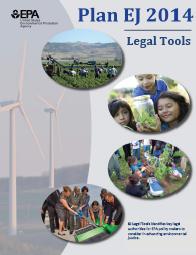
Last fall, in a speech I gave at an environmental justice event in Los Angeles, I ruffled some feathers with an impromptu line that went something like this: “Believe it or not, federal environmental statutes say nothing directly about environmental justice.” During the “Q & A” I was challenged by an environmental activist and lawyer who listed various ways that advocates had successfully used federal environmental statutes to address inequalities in many of California’s minority and low-income communities.
I saw immediately that I had not been clear. For what I meant was that although environmental statutes could be used to further the interests of social justice, the terrain was not landscaped for that purpose. It took activists with imagination and grit to climb the peaks my questioner was talking about. It took lawyers who could scan the glaciers of the federal code and find a foothold—a place where you could jam your steel-toothed boot, stabilize your momentum, and launch yourself forward. (EPA policy analyst Abby Hall and I expand on our theory of regulatory “footholds”—and also regulatory “rope lines”—here.)
 Like community lawyers, policy makers need footholds too. EPA Administrator Lisa Jackson has made environmental justice a pillar of her tenure. But many of our environmental statutes, because they pre-date the modern environmental justice movement, were not developed with this priority in mind. So Administrator Jackson asked her lawyers to survey the landscape of environmental authorities for legal standards and directives that would provide the positioning and leverage to promote “the fair treatment and meaningful involvement of all people regardless of race, color, national origin, or income.” EPA’s lawyers then catalogued those footholds and put them in a guide intended for use across the agency.
Like community lawyers, policy makers need footholds too. EPA Administrator Lisa Jackson has made environmental justice a pillar of her tenure. But many of our environmental statutes, because they pre-date the modern environmental justice movement, were not developed with this priority in mind. So Administrator Jackson asked her lawyers to survey the landscape of environmental authorities for legal standards and directives that would provide the positioning and leverage to promote “the fair treatment and meaningful involvement of all people regardless of race, color, national origin, or income.” EPA’s lawyers then catalogued those footholds and put them in a guide intended for use across the agency.
In an admirable display of integrity and transparency, EPA has now publicly released that guide for all lawyers, activists, and citizens to see – and perhaps use.
The document, titled Plan EJ 2014: Legal Tools, offers “key legal authorities for EPA policy makers to consider in advancing environmental justice.” (Disclosure: as an EPA official in 2009 and 2010, I contributed to the development of environmental justice policy and reviewed legal strategies related to environmental justice.) More than a hundred pages in length, “Legal Tools” reviews enabling provisions along the full armada of environmental acts. There are sections on air programs, water programs, and programs in Indian country. There are discussions of environmental impact statements, government procurement programs, the grant-making process, and more.
Scott Fulton, EPA’s general counsel, emphasizes in a foreword to the report that “Legal Tools” is a “living document” meant to adapt and grow. By necessity, it focuses on “those authorities that appear to be most relevant to the environmental justice challenge as we currently understand it.”
Some of those authorities have already been deployed. When EPA recently required better monitoring of nitrogen dioxide emissions near highways (where low-income and minority populations are more likely to live), it grounded its decision in the Clean Air Act’s injunction to protect public health with an adequate margin of safety, including the duty to consider the vulnerability of “sensitive populations.” (EPA’s recent Interim Guidance on considering environmental justice in rulemaking tells the story nicely.)
Similarly, in proposing new controls on hazardous-material recycling, EPA relied on an express concern for public health stated in the Resources Conservation and Recovery Act (40 C.F.R §§ 260, 261, 266) to support a full examination of demographic analysis and a specially tailored community engagement plan.
Given the scope of the “Legal Tools” inventory, there are bound to be spots in need of expansion and improvement. That’s why “Legal Tools” should be circulated widely among scholars, lawyers, and other interested readers. Let’s start talking about the next pinnacle EPA should confront. Few mountains have handrails. But the footholds are there.
Robert Verchick, Gauthier-St. Martin Chair in Environmental Law, Loyola University, New Orleans. Bio.
| 1 We agree that the citizen at large should not be required to use "imagination and grit to climb the peaks" for social justice. Thank you for your post. -- Sandy Rosenthal |
| 2 We agree that the citizen at large should not be required to use "imagination and grit to climb the peaks" for ENVIRONMENTAL justice. And the same for social justice but let's save that for another interesting conversation. -- Sandy Rosenthal |